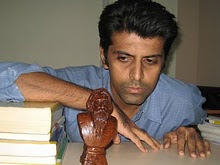'Megharoopan'
A semi-arty Malayalam film is in the making - a biopic on late poet P.Kunhiraman Nair (1906-'78). The poet, known as just "P" (that makes things easy to those non-Mallus who may find his name a twister!), was famous as much for his uniquely Bohemian lifestyle as for the vividly colorful evocations of Keralan landscapes and culture (folk and classical) that fill his work - he was particularly besotted with the Nila river valley and never tired of painting word-landscapes of this idyllic region. The film is titled 'Ivan Megharoopan' (in crude translation, "Behold, a Cloud-like Man!"). A promotional blurb for the movie goes: "What manner of man was this?.... He was no ordinary man, He was Megharoopan!"
I am sort of familiar with the work of P; my involvement with classical Keralan culture - Kathakali, festivals, caparisoned elephants, the works... - is limited albeit real since most of my life happens far away from all that. Whatever, I have to record the making of this movie here because...
Due to a coincidence (as is usually the case with me!), I read, just the otherday, a Malayalam poem by Attoor Ravivarma - 'Megharoopan'. The poem is a celebratory evocation of heroic virtues - loftiness, generosity, joyousness, elegance, invincibility,... congealed together in the immense thunder-cloud like presence of a mighty bull-elephant. The poem gives the tusker, a much-beloved and oft-repeated image of Keralan and Indian tradition, a novel spin, and turns a very famous Kalidasan metaphor inside out: ("the love-lorn Yaksha happened to see a massive thundercloud; it approached, bursting with unbridled power like a tusker toying with a riverine mudbank").
Attoor prefers to hint and suggest rather than describe - 'Megharoopan' never mentions P but his restless spirit is unmistakably present. Beginning "Stature excelling the Sahyan (mountain), generosity greater than the gentle Nila's, virtues of noble forbears assume form and expression in you!", 'Megharoopan' subtly reworks images and metaphors P used to revel in (the vast sand-banks that flank Nila, the moonlight of 'thiruvathira'...), excavating them for deeper epiphanies.
To my knowledge, the makers of 'Ivan Megharoopan' have not mentioned Attoor's poem as the source of the film's name in any online document on the movie. It is possible, the word 'megharoopan' was originally coined by P himself; but I do feel Attoor deserves an honorable mention.
On a personal note:
Here is the last stanza of Attoor's poem in the original Malayalam (a reference to the famous parable of the "blind men examining the elephant" and the Keralan practice of twisting strands of hair from elephant tails into simple finger rings (mothiram)(*)
"Andhar nin tumbiyum kombum
pallayum thott-idanjitaam;
enikku kothi nin valin
romam kondoru mothiram!"
I would rather have 'vambar' (worthies) instead of 'andhar' (blind men) there; here is an approximate translation of this personalized version:
"Let the worthies carry on their learned disputes over your tusk, trunk and bulk. But I crave only for a little 'mothiram' (finger-ring) from your tail"
And that articulates, to perfection, my credo vis-a-vis Mathematics and Mathematicians.
----------
(*) Elephant tail rings and bracelets are worn even in Africa as talismans, I am told.
I am sort of familiar with the work of P; my involvement with classical Keralan culture - Kathakali, festivals, caparisoned elephants, the works... - is limited albeit real since most of my life happens far away from all that. Whatever, I have to record the making of this movie here because...
Due to a coincidence (as is usually the case with me!), I read, just the otherday, a Malayalam poem by Attoor Ravivarma - 'Megharoopan'. The poem is a celebratory evocation of heroic virtues - loftiness, generosity, joyousness, elegance, invincibility,... congealed together in the immense thunder-cloud like presence of a mighty bull-elephant. The poem gives the tusker, a much-beloved and oft-repeated image of Keralan and Indian tradition, a novel spin, and turns a very famous Kalidasan metaphor inside out: ("the love-lorn Yaksha happened to see a massive thundercloud; it approached, bursting with unbridled power like a tusker toying with a riverine mudbank").
Attoor prefers to hint and suggest rather than describe - 'Megharoopan' never mentions P but his restless spirit is unmistakably present. Beginning "Stature excelling the Sahyan (mountain), generosity greater than the gentle Nila's, virtues of noble forbears assume form and expression in you!", 'Megharoopan' subtly reworks images and metaphors P used to revel in (the vast sand-banks that flank Nila, the moonlight of 'thiruvathira'...), excavating them for deeper epiphanies.
To my knowledge, the makers of 'Ivan Megharoopan' have not mentioned Attoor's poem as the source of the film's name in any online document on the movie. It is possible, the word 'megharoopan' was originally coined by P himself; but I do feel Attoor deserves an honorable mention.
On a personal note:
Here is the last stanza of Attoor's poem in the original Malayalam (a reference to the famous parable of the "blind men examining the elephant" and the Keralan practice of twisting strands of hair from elephant tails into simple finger rings (mothiram)(*)
"Andhar nin tumbiyum kombum
pallayum thott-idanjitaam;
enikku kothi nin valin
romam kondoru mothiram!"
I would rather have 'vambar' (worthies) instead of 'andhar' (blind men) there; here is an approximate translation of this personalized version:
"Let the worthies carry on their learned disputes over your tusk, trunk and bulk. But I crave only for a little 'mothiram' (finger-ring) from your tail"
And that articulates, to perfection, my credo vis-a-vis Mathematics and Mathematicians.
----------
(*) Elephant tail rings and bracelets are worn even in Africa as talismans, I am told.

